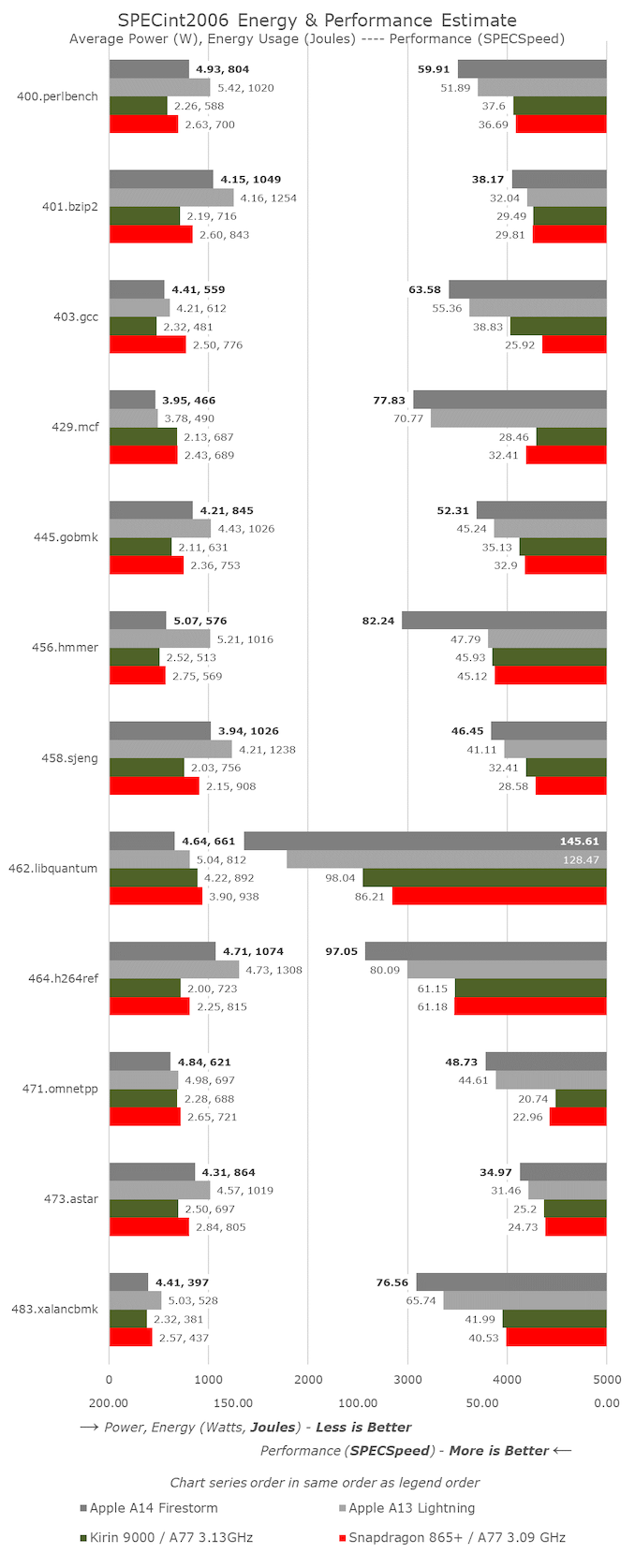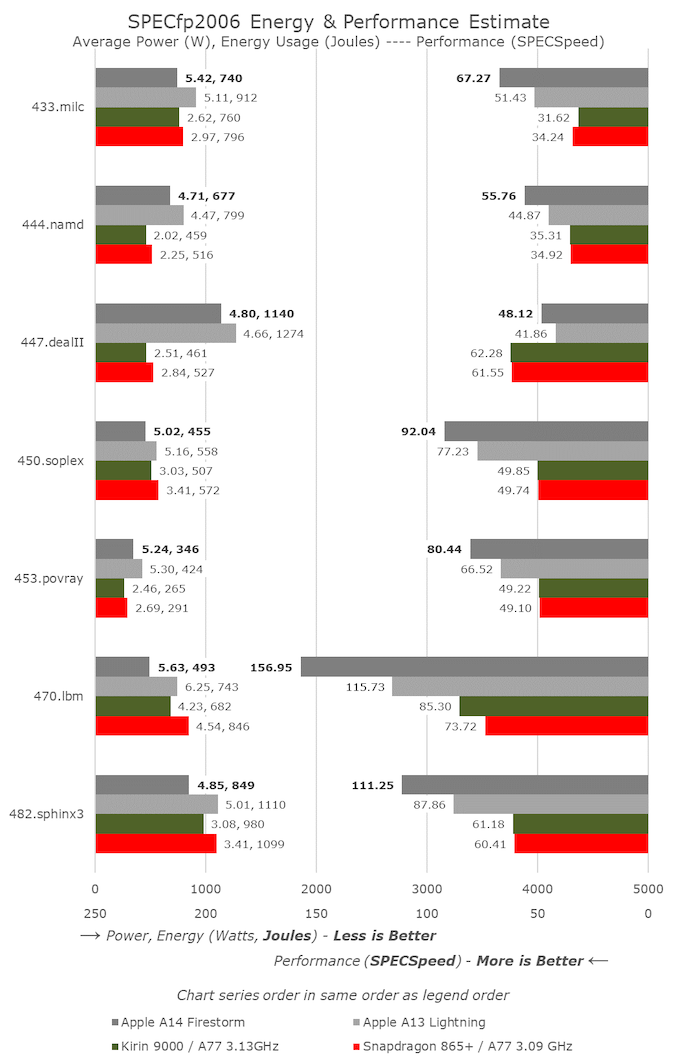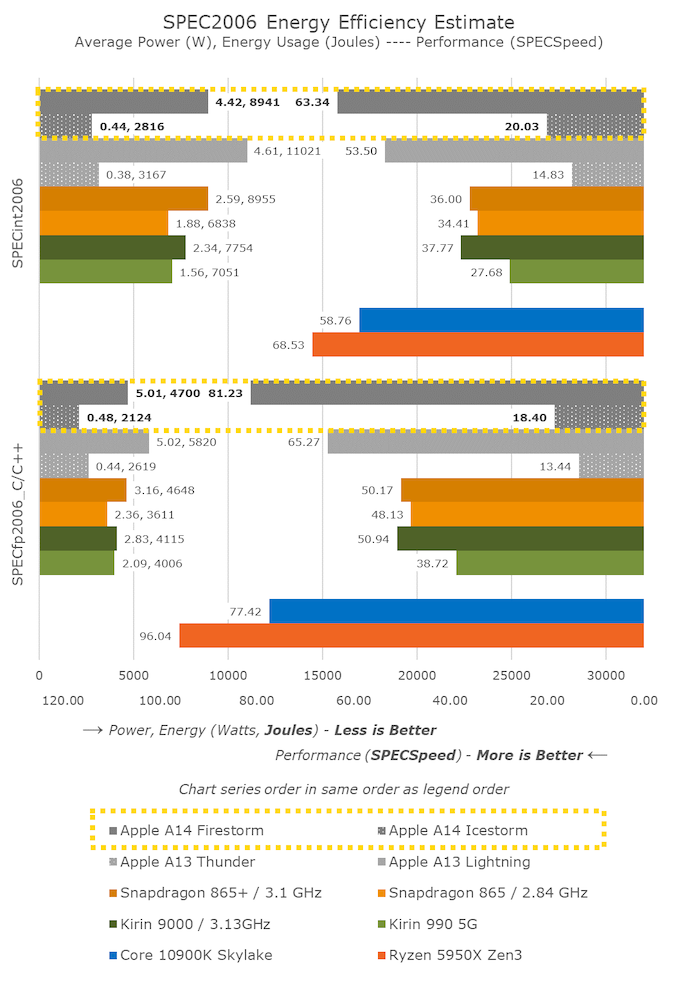Apple Announces The Apple Silicon M1: Ditching x86 - What to Expect, Based on A14
by Andrei Frumusanu on November 10, 2020 3:00 PM EST- Posted in
- Apple
- Apple A14
- Apple Silicon
- Apple M1
Dominating Mobile Performance
Before we dig deeper into the x86 vs Apple Silicon debate, it would be useful to look into more detail how the A14 Firestorm cores have improved upon the A13 Lightning cores, as well as detail the power and power efficiency improvements of the new chip’s 5nm process node.
The process node is actually quite the wildcard in the comparisons here as the A14 is the first 5nm chipset on the market, closely followed by Huawei’s Kirin 9000 in the Mate 40 series. We happen to have both devices and chips in house for testing, and contrasting the Kirin 9000 (Cortex-A77 3.13GHz on N5) vs the Snapdragon 865+ (Cortex-A77 3.09GHz on N7P) we can somewhat deduct how much of an impact the process node has in terms of power and efficiency, translating those improvements to the A13 vs A14 comparison.
Starting off with SPECint2006, we don’t see anything very unusual about the A14 scores, save the great improvement in 456.hmmer. Actually, this wasn’t due to a microarchitectural jump, but rather due to new optimisations on the part of the new LLVM version in Xcode 12. It seems here that the compiler has employed a similar loop optimisation as found on GCC8 onwards. The A13 score actually had improved from 47.79 to 64.87, but I hadn’t run new numbers on the whole suite yet.
For the rest of the workloads, the A14 generally looks like a relatively linear progression from the A13 in terms of progression, accounting for the clock frequency increase from 2.66GHz to 3GHz. The overall IPC gains for the suite look to be around 5% which is a bit less than Apple’s prior generations, though with a larger than usual clock speed increase.
Power consumption for the new chip is actually in line, and sometimes even better than the A13, which means that workload energy efficiency this generation has seen a noticeable improvement even at the peak performance point.
Performance against the contemporary Android and Cortex-core powered SoCs looks to be quite lopsided in favour of Apple. The one thing that stands out the most are the memory-intensive, sparse memory characterised workloads such as 429.mcf and 471.omnetpp where the Apple design features well over twice the performance, even though all the chip is running similar mobile-grade LPDDR4X/LPDDR5 memory. In our microarchitectural investigations we’ve seen signs of “memory magic” on Apple’s designs, where we might believe they’re using some sort of pointer-chase prefetching mechanism.
In SPECfp, the increases of the A14 over the A13 are a little higher than the linear clock frequency increase, as we’re measuring an overall 10-11% IPC uplift here. This isn’t too surprising given the additional fourth FP/SIMD pipeline of the design, whereas the integer side of the core has remained relatively unchanged compared to the A13.
In the overall mobile comparison, we can see that the new A14 has made robust progress in terms of increasing performance over the A13. Compared to the competition, Apple is well ahead of the pack – we’ll have to wait for next year’s Cortex-X1 devices to see the gap narrow again.
What’s also very important to note here is that Apple has achieved this all whilst remaining flat, or even lowering the power consumption of the new chip, notably reducing energy consumption for the same workloads.
Looking at the Kirin 9000 vs the Snapdragon 865+, we’re seeing a 10% reduction in power at relatively similar performance. Both chips use the same CPU IP, only differing in their process node and implementations. It seems Apple’s A14 here has been able to achieve better figures than just the process node improvement, which is expected given that it’s a new microarchitecture design as well.
One further note is the data of the A14’s small efficiency cores. This generation we saw a large microarchitectural boost on the part of these new cores which are now seeing 35% better performance versus last year’s A13 efficiency cores – all while further reducing energy consumption. I don’t know how the small cores will come into play on Apple’s “Apple Silicon” Mac designs, but they’re certainly still very performant and extremely efficient compared to other current contemporary Arm designs.
Lastly, there’s the x86 vs Apple performance comparison. Usually for iPhone reviews I comment on this in this section of the article, but given today’s context and the goals Apple has made for Apple Silicon, let’s investigate that into a whole dedicated section…













644 Comments
View All Comments
BedfordTim - Friday, November 13, 2020 - link
The reason is that until recently they weren't good enough, and that there was a chicken and egg situation with software.That changed with the Neoverse cores and you could equally ask why Amazaon and other are now offering ARM servers.
Silver5urfer - Sunday, November 15, 2020 - link
People forget things and people do not know what they are even talking about. Marvell Thunder X3 article right here on AT it was purported to be challenging AMD and Intel. And they abandoned the SKUs for the general purpose meaning, they won't be selling off shelf parts. They will do a custom chip if any company wants them like Graviton for AWS is custom like that Marvell will do for X company per se.And next we go to even further past, Qualcomm Centriq, remember Cloudflare advertisement on the Centriq, they were over the top for that CPU infrastructure. And then what happened ? Fizzled out, Qualcomm axed the whole Engg. Team forever which was the team who made 820 Kryo full custom chip (why did qcomm made full custom ? 810 and 64Bit disaster) and we have Nuvia, Altera, both have to prove themselves, EPYC7742 is the leading champion in the arena right now, Intel is trying so hard to contain the beast of AMD still no viable product, until their 10nmSF is ready.
And here we have people reading this article which has mentioned only GB and Apple graph and then specint perf charts with Single Core performance only and then deciding on Intel and AMD are dead along with x86. Hilarious and even on hackernews, people are discussing some bs medium post on how Intel is going to get shunned...
The world runs on Intel and AMD is just 6.6%, and we have people thinking Samsung and Qualcomm, Huawei are going to come at Intel. Epic joke really. Even more funny part is how Intel Macs are still on Apple.com website at a higher price tag, WHY WILL APPLE STILL KEEP INTEL CPUs IF THIS M1 IS FASTER THAN 5950X and 10900K GOD KNOWS !!!
Sailor23M - Friday, November 13, 2020 - link
^^This. I fully expect Samsung to launch their own Arm chip based laptop and then grow from there to perhaps servers as well.duploxxx - Monday, December 7, 2020 - link
Medium term?You mean people moving to the over expensive eco system of apple because they have a better device that is only compatible with 5-10% of the available sw?
Moving away from x86 neither that will happen. But only for the parts that are written for mobile devices. Back end sw is not just shifting over. Arm servers are evolving but far from x86 portfolio. Only amazon is showing some progress in there own platform which they offer very cheap to bring people over. Those who dev in cloud look into future portability and complain e. Much to discuss about that.
SarahKerrigan - Tuesday, November 10, 2020 - link
The number of in-flight loads and stores the Firestorm core can sustain is just crazy.lilmoe - Tuesday, November 10, 2020 - link
Numbers are looking great for Zen3. ARM X1 should also give Firestorm a run for its money. That being said, the key advantage of the M1 platform will be its more advanced co-processors, coupled with mainstream adoption, should drive devs to build highly optimized apps that run circles around any CPU bound workload... Sure NVidia has Cuda, but it won't be nearly as wide-spread as the M1, and not nearly as efficient. If done right, you can saw bye-bye to CPU-first compute.Ppietra - Tuesday, November 10, 2020 - link
considering what is known ARM X1 will still be quite behindKurosaki - Tuesday, November 10, 2020 - link
Yes, several generations behind, but Intel would still be worse. Crazy world nowadays! :DMgradon - Tuesday, November 10, 2020 - link
Well, it is not the question of CPU speed only. PowerPC was better then Intel but this did not help Apple. Moving the code of all key software to native Apple OS code will take long time, and in virtual mode speed of those CPUs will be low. I am using now MacBook Pro, do I want to be like a beta tester with OS based on IPhone ecosystem - not really convinced.Kilnk - Tuesday, November 10, 2020 - link
Apple reports that graphics-intensive apps run faster on Rosetta on this chip than they were running natively on previous Macs with integrated graphics. It's in the keynote at 18:26. That's how fast it is.